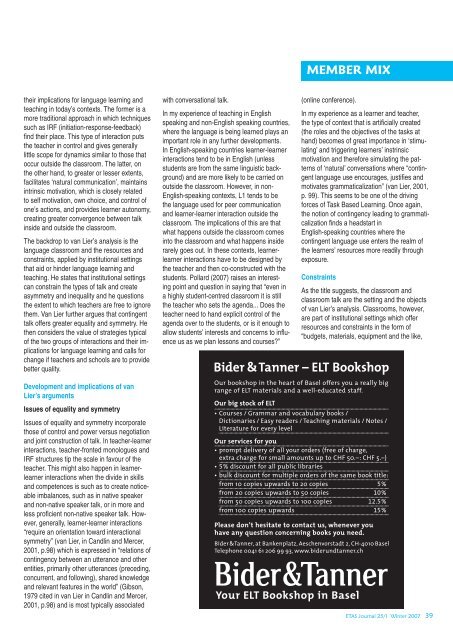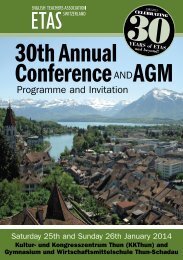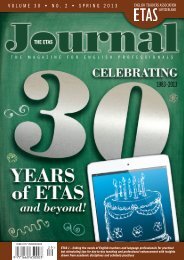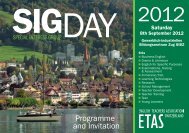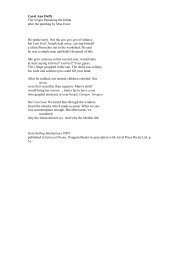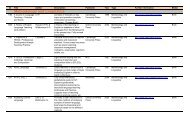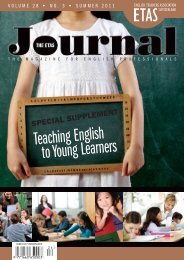The Magazine for English Professionals - English Teachers ...
The Magazine for English Professionals - English Teachers ...
The Magazine for English Professionals - English Teachers ...
Create successful ePaper yourself
Turn your PDF publications into a flip-book with our unique Google optimized e-Paper software.
their implications <strong>for</strong> language learning and<br />
teaching in today’s contexts. <strong>The</strong> <strong>for</strong>mer is a<br />
more traditional approach in which techniques<br />
such as IRF (initiation-response-feedback)<br />
find their place. This type of interaction puts<br />
the teacher in control and gives generally<br />
little scope <strong>for</strong> dynamics similar to those that<br />
occur outside the classroom. <strong>The</strong> latter, on<br />
the other hand, to greater or lesser extents,<br />
facilitates ‘natural communication’, maintains<br />
intrinsic motivation, which is closely related<br />
to self motivation, own choice, and control of<br />
one’s actions, and provides learner autonomy,<br />
creating greater convergence between talk<br />
inside and outside the classroom.<br />
<strong>The</strong> backdrop to van Lier’s analysis is the<br />
language classroom and the resources and<br />
constraints, applied by institutional settings<br />
that aid or hinder language learning and<br />
teaching. He states that institutional settings<br />
can constrain the types of talk and create<br />
asymmetry and inequality and he questions<br />
the extent to which teachers are free to ignore<br />
them. Van Lier further argues that contingent<br />
talk offers greater equality and symmetry. He<br />
then considers the value of strategies typical<br />
of the two groups of interactions and their implications<br />
<strong>for</strong> language learning and calls <strong>for</strong><br />
change if teachers and schools are to provide<br />
better quality.<br />
Development and implications of van<br />
Lier’s arguments<br />
Issues of equality and symmetry<br />
Issues of equality and symmetry incorporate<br />
those of control and power versus negotiation<br />
and joint construction of talk. In teacher-learner<br />
interactions, teacher-fronted monologues and<br />
IRF structures tip the scale in favour of the<br />
teacher. This might also happen in learnerlearner<br />
interactions when the divide in skills<br />
and competences is such as to create noticeable<br />
imbalances, such as in native speaker<br />
and non-native speaker talk, or in more and<br />
less proficient non-native speaker talk. However,<br />
generally, learner-learner interactions<br />
“require an orientation toward interactional<br />
symmetry” (van Lier, in Candlin and Mercer,<br />
2001, p.98) which is expressed in “relations of<br />
contingency between an utterance and other<br />
entities, primarily other utterances (preceding,<br />
concurrent, and following), shared knowledge<br />
and relevant features in the world” (Gibson,<br />
1979 cited in van Lier in Candlin and Mercer,<br />
2001, p.98) and is most typically associated<br />
with conversational talk.<br />
In my experience of teaching in <strong>English</strong><br />
speaking and non-<strong>English</strong> speaking countries,<br />
where the language is being learned plays an<br />
important role in any further developments.<br />
In <strong>English</strong>-speaking countries learner-learner<br />
interactions tend to be in <strong>English</strong> (unless<br />
students are from the same linguistic background)<br />
and are more likely to be carried on<br />
outside the classroom. However, in non-<br />
<strong>English</strong>-speaking contexts, L1 tends to be<br />
the language used <strong>for</strong> peer communication<br />
and learner-learner interaction outside the<br />
classroom. <strong>The</strong> implications of this are that<br />
what happens outside the classroom comes<br />
into the classroom and what happens inside<br />
rarely goes out. In these contexts, learnerlearner<br />
interactions have to be designed by<br />
the teacher and then co-constructed with the<br />
students. Pollard (2007) raises an interesting<br />
point and question in saying that “even in<br />
a highly student-centred classroom it is still<br />
the teacher who sets the agenda... Does the<br />
teacher need to hand explicit control of the<br />
agenda over to the students, or is it enough to<br />
allow students’ interests and concerns to influence<br />
us as we plan lessons and courses?”<br />
MEMBER MIX<br />
(online conference).<br />
In my experience as a learner and teacher,<br />
the type of context that is artificially created<br />
(the roles and the objectives of the tasks at<br />
hand) becomes of great importance in ‘stimulating’<br />
and triggering learners’ instrinsic<br />
motivation and there<strong>for</strong>e simulating the patterns<br />
of ‘natural’ conversations where “contingent<br />
language use encourages, justifies and<br />
motivates grammaticalization” (van Lier, 2001,<br />
p. 99). This seems to be one of the driving<br />
<strong>for</strong>ces of Task Based Learning. Once again,<br />
the notion of contingency leading to grammaticalization<br />
finds a headstart in<br />
<strong>English</strong>-speaking countries where the<br />
contingent language use enters the realm of<br />
the learners’ resources more readily through<br />
exposure.<br />
Constraints<br />
As the title suggests, the classroom and<br />
classroom talk are the setting and the objects<br />
of van Lier’s analysis. Classrooms, however,<br />
are part of institutional settings which offer<br />
resources and constraints in the <strong>for</strong>m of<br />
“budgets, materials, equipment and the like,<br />
Bider &Tanner – ELT Bookshop<br />
Our bookshop in the heart of Basel offers you a really big<br />
range of ELT materials and a well-educated staff.<br />
Our big stock of ELT<br />
• Courses / Grammar and vocabulary books /<br />
Dictionaries / Easy readers / Teaching materials / Notes /<br />
Literature <strong>for</strong> every level<br />
Our services <strong>for</strong> you<br />
• prompt delivery of all your orders (free of charge,<br />
extra charge <strong>for</strong> small amounts up to CHF 50.–: CHF 5.–)<br />
• 5% discount <strong>for</strong> all public libraries<br />
• bulk discount <strong>for</strong> multiple orders of the same book title:<br />
from 10 copies upwards to 20 copies 5%<br />
from 20 copies upwards to 50 copies 10%<br />
from 50 copies upwards to 100 copies 12.5%<br />
from 100 copies upwards 15%<br />
Please don’t hesitate to contact us, whenever you<br />
have any question concerning books you need.<br />
Bider &Tanner, at Bankenplatz, Aeschenvorstadt 2, CH-4010 Basel<br />
Telephone 0041 61 206 99 93, www.biderundtanner.ch<br />
ETAS Journal 25/1 Winter 2007 39


